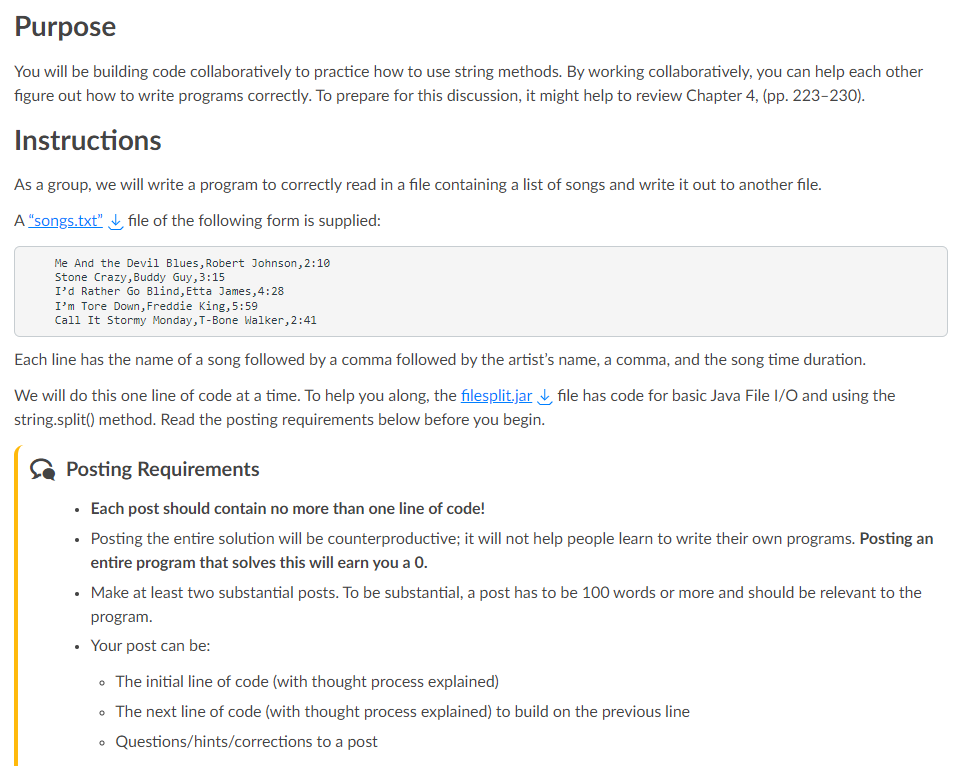Practicing Assignments Before Taking Graded Assessments
Overview
Students unlock a graded assignment by completing a series of practice activities.
Why Use This?
Practice activities for an assignment build confidence, illuminate areas where students may need to refresh their knowledge, and make the course more equitable by allowing students to openly discuss the assignments with their peers and get help on their own schedules.
How Does It Work?
In this applied computing course, three practice activities are grouped together in the module: a pre-quiz, a list of resources to review, and a discussion activity. Students must complete all three activities before the graded assignment becomes available.

About
- The purpose of this quiz is to:
- Give you the confidence that you are ready to work on Assignment 1;
- And to discover areas where you may need a review before moving forward with Assignment 1.
- Once you take the quiz, you will get feedback on any questions you missed.
- This feedback will reference the information on the Assignment 1 Pre-Quiz Feedback Page.
- You may take the quiz as many times as you wish. Your highest score will be recorded.
If you discover you need help with any concepts, that’s ok! Review the resources from the feedback and please reach out (early) to your instructor if you need help so you have plenty of time to work on Assignment 1.

Quiz Question(s)TopicReview Materials1How to open a file for reading, handle file I/O exceptions, store objects in a fileAPC 350 Lecture: File Input/Output2, 3How to set up a class that stores an array of objects; How to use a toString method
Textbook chapter 8, pp. 465-485
APC 350 Lecture: Classes, Objects, Methods, and their Graphical RepresentationAPC 350 Lecture: Defining Classes and Their Class and Instance Members;APC 350 Lecture: Public and Private Members4Setting up a constructor for a classTextbook chapter 8, pp. 485-517APC 350 Lecture: ConstructorsAPC 350 Lecture: Memory Representation of Objects and Copy Constructors5Setting up a copy constructor for a classSame as 46Using a class copy constructorSame as 47Setting up a toString methodTextbook chapter 8, pp. 517-536APC 350 Lecture: toString Method and Its Use in ProgramsAPC 350 Lecture: Java Packages and Data Abstraction8Using a toString methodSame as 79Setting references in an array of object referencesTextbook chapter 9, pp. 552-559APC 350 Lecture: ArraysAPC 350 Lecture: Arrays Continued10Incorrect way to check whether two arrays are the sameTextbook chapter 9, pp. 559-564APC 350 Lecture: Sequential Processing of Array ElementsAPC 350 Lecture: Array Initialization with User InputsAPC 350 Lecture: Parallel Arrays

Purpose
You will be building code collaboratively to practice how to use string methods. By working collaboratively, you can help each other figure out how to write programs correctly. To prepare for this discussion, it might help to review Chapter 4, (pp. 223–230).
Instructions
As a group, we will write a program to correctly read in a file containing a list of songs and write it out to another file.
A “songs.txt” Download “songs.txt”file of the following form is supplied:
Me And the Devil Blues,Robert Johnson,2:10
Stone Crazy,Buddy Guy,3:15
I’d Rather Go Blind,Etta James,4:28
I’m Tore Down,Freddie King,5:59
Call It Stormy Monday,T-Bone Walker,2:41
Each line has the name of a song followed by a comma followed by the artist’s name, a comma, and the song time duration.
We will do this one line of code at a time. To help you along, the filesplit.jar Download filesplit.jarfile has code for basic Java File I/O and using the string.split() method. Read the posting requirements below before you begin.
Posting Requirements
-
- Each post should contain no more than one line of code!
- Posting the entire solution will be counterproductive; it will not help people learn to write their own programs. Posting an entire program that solves this will earn you a 0.
- Make at least two substantial posts. To be substantial, a post has to be 100 words or more and should be relevant to the program.
- Your post can be:
- The initial line of code (with thought process explained)
- The next line of code (with thought process explained) to build on the previous line
- Questions/hints/corrections to a post
Keep In Mind
- In computing courses like this one, make sure you restrict students to posting one line of code rather than an entire program so as not to give away the solution to the assignment prompt.
- A variation on the discussion strategy would be to ask students to solve a problem themselves (instead of collaboratively) so they can see how their classmates solved the same problem.